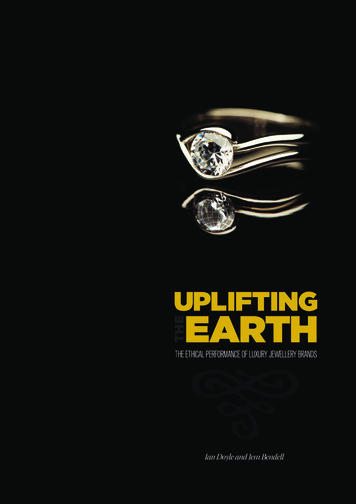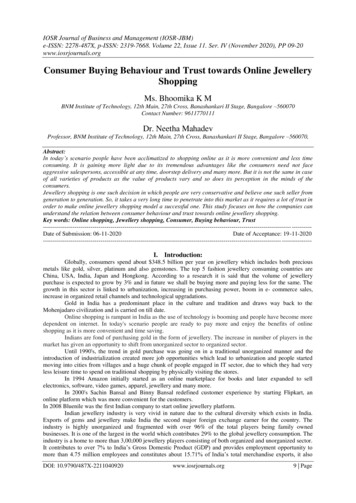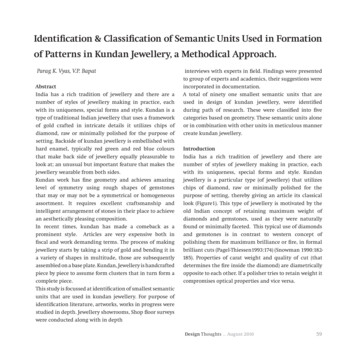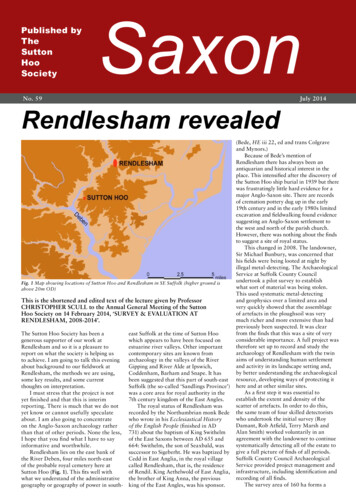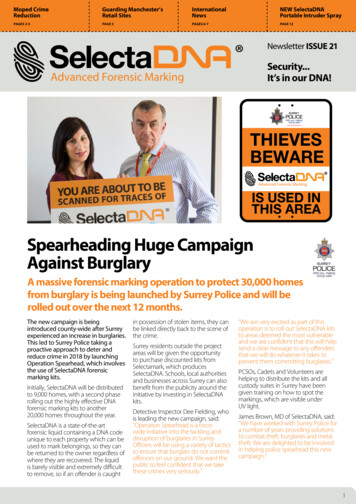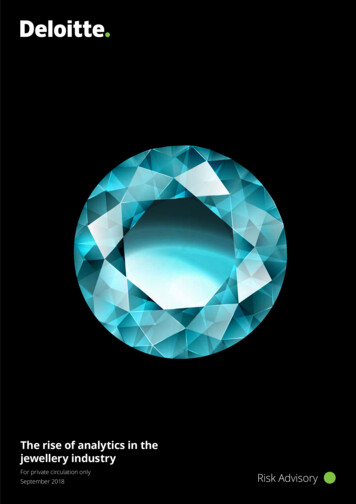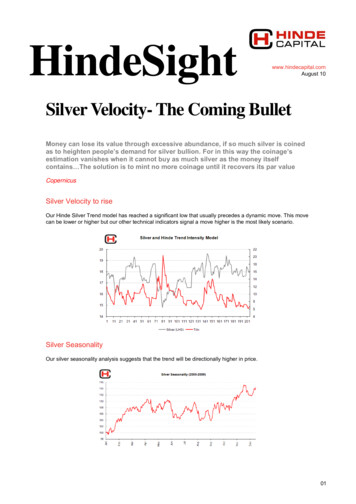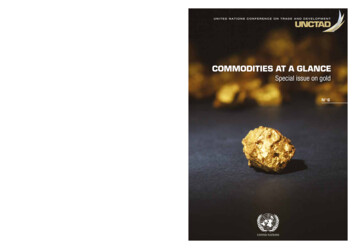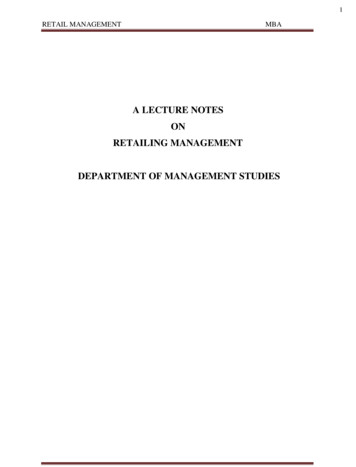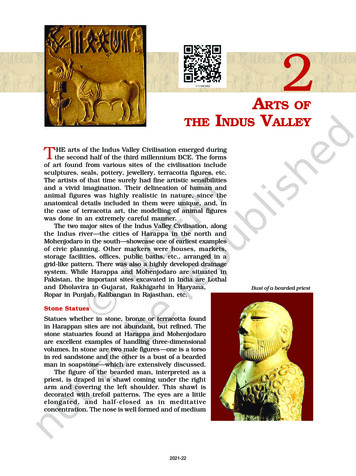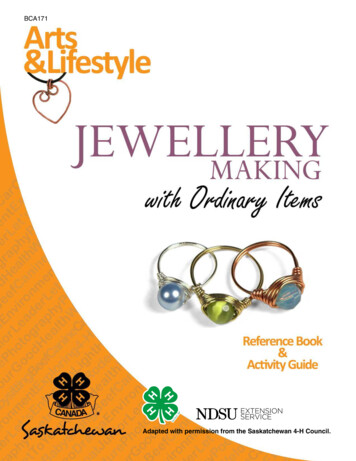
Transcription
BCA171Adapted with permission from the Saskatchewan 4-H Council.
4-H MOTTOLearn to do by doing.4-H MOTTOLearn to do by doing.4-H PLEDGEI pledge4-HPLEDGEMy HEADto clearer thinking,HEART to greater loyalty,IMypledgeHANDStotoclearerlarger thinking,service,My HEADHEALTHtotogreaterbetter loyalty,living,My HEARTFor HANDSmy club,tomycommunityMylargerservice, and my country.My HEALTH to better living,For my club, my community and my country.4-H GRACE(Tune of Auld Lang Syne)4-HGRACEWe thank thee, Lord, for blessings great(Tune of Auld Lang Syne)On this, our own fair land.Teachus tothee,servetheeforjoyfully,WethankLord,blessings greatWithhead,healthOn this,ourheart,own fairland.and hand.Teach us to serve thee joyfully,With head, heart, health and hand.This project was developed through funds provided by the Canadian AgriculturalAdaptation Program (CAAP). No portion of this manual may be reproduced withoutwrittenpermissionfrom thethroughSaskatchewan4-H Council,phone306-933-7727,email:This projectwas developedfunds providedby 13. of this manual may be reproduced withoutAdaptation Program(CAAP).MayNo portionwritten permission from the Saskatchewan 4-H Council, phone 306-933-7727, email:Writer:Kristal Kennett,BSc MayHon,2013.MRMinfo@4-h.sk.ca.Developed:Writer: Kristal Kennett, BSc Hon, MRMAdapted with permission from the Saskatchewan 4-H Council.
Table of ContentsIntroduction .1Objectives .1Achievement Day Requirements of this Project .1Resources for Learning .1Organization of Project .2Internet Activity .2Safety First .3About Jewellery .4Types of Jewellery .4Featured Materials .5Other Materials .9Tools and Equipment .19Equipment and Tool Worksheet .27Unit 1: Paper .30Paper Beads .Activity 1 – Paper Beads .Activity 2 – Simple Beaded Bracelet .303235Découpage .Activity 3 – Découpage Pendant .4840Origami .Activity 4 – Origami Heart Pendant .4344Unit 2: Fibre .47Braiding .Activity 5 – Wish Bracelet .Activity 6 – Braided Bracelet with Dual Beads and Button Closure .474851Macramé .Activity 7 – Practice your Macramé Knots .5458Q In this publication please note the UK spelling of fiber is “fibre” and the spelling of jewelry is “jewellery.” Q
Activity 8 – Spiral Knot Bracelet .Activity 9 – Friendship Bracelet Loom .Activity 10 – Friendship Bracelet (Candy Striped Friendship Bracelet) .Activity 11 – Sliding Clasp Knot .60636470Using Fabric .Activity 12 – Jersey Knit Bracelet .Activity 13 – Fabric Rosette Pendant .Activity 14 – Fabric Rosette Bracelet .74748083Felting .Activity 15 – Felted Beads .8686Unit 3: Wire .89Jewellery Making Basics .Activity 16 – Opening and Closing Jump Rings .Activity 17 – Wire Looping and Making a Dangle .Activity 18 – Wire Wrapping and Making a Dangle .Activity 19 – Linking Components .9090929599Making Our Own Findings .Activity 20 – Making Jump Rings .Activity 21 – Earring Hooks or Ear Wires .Activity 22 – Making a S-Clasp .101101103105Making Wire Jewellery .Activity 23 – Making Wrapper Wire Rings .Activity 24 – Wire Heart Pendant .Activity 25 – Wire Wrapped Bead .Activity 26 – Wire Wrapped Beaded Ring .Activity 27 – Bird Nest Pendant .107107109112115118Unit 4: Polymer Clay . 120Basic Shapes .Activity 28 – Making a Ball and Basic Beads .Activity 29 – Making a Slab and a Simple Pendant .Activity 30 – Making a Log or Snake and Identical-sized Beads .121121124128Polymer Clay Canes . 131Activity 31 – Making a Bull’s Eye Cane and Chuynky Beads . 132Activity 32 – Jelly Roll or Swirl Cane and Flat Beads . 135Unit 5: Repurposed Objects . 138Activity 33 – Washer Pendant . 138Activity 34 – Button Bracelet . 142
Activity 35 – Safety Pin Bracelet .Activity 36 – Vinyl Tubing Bracelet .Activity 37 – Tile Pendant .Activity 38 – Beaded Fabric Necklace or the Necktie Necklace .145148151154Unit 6: Recycled Objects . 157Activity 39 – Water Bottle Dangles .Activity 40 – Gift Card Bracelet .Activity 41 – Découpage Tape Reel Bracelet .Activity 42 – Cork Flower Earrings .Activity 43 – Bottle Cap Bracelet .Activity 44 – Pop Can Tab Bracelet .157160163165167170Making Your Own Jewellery . 173Bibliography . 174
IntroductionObjectivesIn this project, you will be learning an array of jewellery-making techniques, while exploringthe use of ordinary household items to make attractive and interesting jewellery.Materials for jewellery making can be expensive but this project focuses on commonlyavailable objects. However, you will have to purchase some materials like polymer clay orsterling silver wire. By using items from our day to day lives, we can minimize costs andchallenge our creativity. To assist in keeping costs down, worksheet of materials and tools isprovided to identify opportunities to share and borrow.While you are not required to do all the activities, completing them will give you more exposureto ideas and more practice of techniques leading to more skill and ability in jewellery-making.Achievement Day Requirements of this Project Completed record book. At least one item from each of the major sections of Paper, Fibre, Wire, Polymer Clay,Repurposed and Recycled for a total of six pieces of jewellery or jewellery components.Getting the Most from this Project Attend club and project activities regularly. Listen and ask questions. You will learn from each other as well as your leader. Undertake as many activities and techniques as possible so you can ‘learn to do by doing’.Resources for Learning People – members of our communities and beyond can have jewellery-making or craft skills. Websites – the Internet is a good source of information and inspiration, includingvideos on websites like youtube. Books and magazines – libraries are often a good source for inspiration as well as areference on jewellery-making and other techniques.Jewellery Making with Ordinary Items 1
Craft stores – sales people can be helpful and many stores stock project sheets oroffer lessons in using various tools and equipment.Organization of ProjectThis project is organized by materials and then the techniques that can be used to makejewellery from those materials. In keeping with the 4-H motto, in this project you will learnto do by doing, and as such activities are integrated with the resource information. Themore activities you undertake, the more opportunities you will have to work with thematerials and tools and the more you will master the techniques.Each activity is supported by: A description of the activity objective which is usually a technique resulting in a pieceof jewellery or a jewellery component. Sometimes, tips and hints to assist you in the technique. The time required to complete item the first time; as you master the technique, thetime needed will be less and less. A list of materials and tools. The activity instructions. Online resources with links to web pages or videos. Post-activity questions where you can document your experience of using thatmaterial or technique. A listing of other ideas and internet resources utilizing similar technique or material.In the listings of materials required, both metric and imperial measurements are given. Inmany cases, these are not direct conversions as that level of accuracy is not required.Instead, they are practical measurements specifying amount of materials to undertake theactivity. For example, it is much easier to measure two inches than 1.96 inches, which is theequivalent to five centimetres.Finally, before you undertake an activity, read through the description, materials and tools,and instructions to gain an understanding of the task at hand. Find a work area with goodlight and a hard, flat surface. Be sure to gather ALL your materials and tools before you start.Internet ActivityAs mentioned, at the end of activities are some online resources providing links to webpages or video. This is to supplement the instructions provided as well as provide somedifferent ideas of what can be done with those materials utilizing a similar technique.2 Jewellery Making with Ordinary Items
The Internet is a great resource for information, ideas, instructions and inspiration. If youare using the Internet, follow these guidelines: If you post online, NEVER attach any personal information such as names, addresses,phone numbers, date of birth, what school you attend, etc. ALWAYS remember the person you are communicating with may not be the personthey claim to be. When using social media sites like Facebook, set your online profile to private. Thatway, only people who will be able to see your profile will be those that you approve. Do not give your passwords to anyone but your parent or guardian. Never meet anyone in person that you just met on social media sites. If anything happens online that makes you feel scared or uncomfortable, ALWAYS tellyour parent or guardian. Report any inappropriate comments or messages if theyviolate the terms of service for that site.Safety FirstAs well as being careful on the Internet, we need to be cautious when using tools and somematerials. Here are some tips on how to be safe: Cutting – many of the activities in this project involve using some sort of cuttinginstrument. Be careful with any sharp blade, and always be conscious of where youput it down after using it. Paints and sprays – the gases that are released when using some paints, sealers andsprays can have harmful fumes that cause head-aches, throat and nose irritation andnausea. Ensure you have good ventilation when using these items. Glues – be careful using fast bonding glues like Superglue to avoid gluing your fingerstogether. Also ensure you have good ventilation while using the stronger adhesives. Wire – when working with wire, it is a good idea to always wear safety goggles orglasses, particularly when cutting wire. Do what you can to protect your eyes andvision from sharp flying wire. Polymer clay – Make any equipment you use with polymer clay ‘dedicated’ and keepit separate from food preparation items. Ensure you have good ventilation whenbaking your polymer clay beads. Appliances and power tools – in some activities, you will be using a hot glue gun, apressing iron or a drill. Exercise caution to keep yourself and others safe. If you areunsure how to use a piece of equipment, ask. Alternatively, have an adult help you.Jewellery Making with Ordinary Items 3
About JewelleryHumans have been making jewellery for centuries, possibly millennia. Jewellery evolvedfrom a form of currency to reflect fashion and art. It has symbolized wealth with the use ofprecious metals and gemstones, or has religious significance indicating membership andstatus within a religion. Some jewellery such as pins, buckles and brooches started offserving a specific function but has evolved to being primarily decoration.Today, jewellery is more an artistic expression and a fashion statement, particularly as toolsand materials become more affordable and available. Focus has shifted from symbolism andsocial status to design, creativity and artistic expression. Now jewellery is primarily astatement of personal expression.In this project, we are going to explore a wide variety of materials and techniques. As wework through the units, you will have the opportunity to try various projects as well asstyles. In most units, internet links are provided to other projects you might like to try.Types of JewelleryJewellery generally falls into five categories – those that decorate our ears as earrings, ourfingers as rings, our arms and our ankles as bracelets, our neck as necklaces and pendants,or our torsos as brooches. In this project, we are primarily going to look at necklaces,pendants and bracelets, although we have a few earrings and rings projects. Many of thetechniques and materials can be applied to the whole range of jewellery.4 Jewellery Making with Ordinary Items
Featured MaterialsIn this project we are going to experiment with a wide variety of materials to producejewellery. Generally, these materials are commonly found, or easily acquired. A worksheet isincluded at the end of this section. Below are the major categories and materials that wewill be exploring.Paper –normally is made from trees which go through apulping process and become paper. However, it can bemade from many other things as well – banana leaves,grasses, etc. In this project, a variety of paper can be usedfor the paper-based activities from recycled glossymagazines, newspaper, junk mail or used gift wrap to newpaper such as scrap book paper, new gift wrap or colouredbond paper.Fibre – encompasses a wide variety of materials including thread, thick cord, fabric andcarded wool. The fibre you will use depends on the task at hand. We are going to use hemptwine for braiding, heavy cord for knot tying andembroidery floss for friendship bracelets. In manyactivities, you can use other types of cord orthread – just keep in mind the diameter of thecord. For example, the cord for the beadedbracelet in Activity 6 lists embroidery cotton;however, you can use linen, no-stretch beadingthread or even fine hemp twine if you so wish.Under this Unit, you will also be using fabrics like jersey knits or woven cotton. Jersey knitfabric is a lightweight stretchy material like a T-shirt. It is easy to work with as it does notfray. In some activities, you might want to use wovencotton instead. These fabrics can be purchased but trysourcing them from old clothes like T-shirts and blousesor even scrap material from other sewing projects.The final fibre type in this unit is carded wool, or wool thathas not yet been spun into yarn. The wool fleece has beencombed or carded into a long rope, ready for spinning orfelting. It is available in a variety of great colours.Jewellery Making with Ordinary Items 5
Wire – is an extruded metal, and is quite versatile in jewellery-making because it can hold itsown shape. It comes in different thicknesses or gauges – the larger the gauge, the smallerthe diameter of the wire. For example, 16-gauge is a much bigger wire than 22-gauge. Mostjewellery is made of the larger gauge (and smallerwire) such as 20, 22 or 24, mostly because it is easy towork with. The smaller gauges, such as 12 and 16 aredifficult to bend and therefore do not lendthemselves easily to jewellery-making.Just about any wire can be used to make jewellery –electrical wire, copper wire, galvanized wire.However, if you are making earring hooks for apierced ear, you should use sterling silver or sterlingsilver coated wire to avoid earlobe infections. Sterlingsilver wire is available in most craft stores.Polymer clay – is polymer polyvinyl chloride (PVC) modeling claythat will harden, thus making firm objects we can use for jewellerymaking. Other PVC items that you may be familiar with are whiteglue (also known as PVC glue) and plastic pipes used in plumbing.Although this product is called ‘clay’, it does not contain any clay. Inits manufacture, liquid is added to dry particles to create a gel-likesubstance that has working properties like clay. And because it isput into an oven to harden, it is referred to as modeling clay.Polymer clay is used for making both two and three dimensional objects and for makingsimple to complex designs. With an array of stunning colours, polymer clay like Fimo andSculpey are fun to use and are readily available in craft sections of most stores.Repurposed objects – as jewellery can be fun. With some creativity, we can transform ordinaryitems like washers, buttons and safety pins into jewellery that has a point of difference.Washers – are disk-shaped thin plates with ahole in the middle that is normally used todistribute the load of a threaded fastener,such as a screw or nut. They are available inany hardware store, or maybe even yourdad’s garage.6 Jewellery Making with Ordinary Items
Buttons – come in two basic types.Flat or sew-through buttons haveeither two or four holes. The thread issewn through those holes to attachthe button to fabric. The second type,the shank button does not have visibleholes but has a small ring or bar with ahole called a shank. It protrudes fromthe back, and that is where the thread goes through to attach the button to the fabric. Wewill be using flat buttons for our crafts. These are available in stores selling crafts orsewing supplies. You might also be able to raid your mother’s sewing supplies.Safety pin – is a pin bent back on itself to form a spring, with a guard to cover the point.The guard, or clasp, serves to form a closed loop whichproperly fastening the pin. It also covers the end ofthe pin to protect the user from the sharp point.Safety pins are commonly used to fasten piecesof fabric or clothing together such as clothdiapers or torn clothing. They are easilyacquired from craft or fabric stores as wellas supermarkets and department stores.Vinyl tubing – is a clear, lightweight and flexible hose usedto transfer fluids in plumbing, wine making andmedicine. It can generally be found in the plumbingsection of your hardware store or in a store thatstocks wine making or medical supplies. Do not reuseany that may have been used to transfer blood or bloodproducts, or hydrocarbons like gasoline.Tiles – from games like scrabble or dominoescan be repurposed into jewellery. If you donot have game pieces that you can use froman existing game, they often can bepurchased from a craft store or a thrift store.Or you could look in the dollar stores forgames that have interesting game pieces.Man’s tie – is source of material to make fabric jewellery. Ties are often made of silk andare beautifully designed. Thrift stores are a good source, or you might be able to raidyour grandfather’s or father’s closet for one. The wider, the better for this activity. Ifyou cannot find a suitable tie, you can use fabric.Jewellery Making with Ordinary Items 7
Recycled objects – can also be used to make jewellery. What might be destined to thelandfill or recycle centre can be reworked, or ‘upcycled’, into eye-catching jewellery. Youmight have to start collecting these items early on so that you have them available whenyou undertake this section.Plastic pop bottle – like a disposable PET drink bottle, can be cut and used to make avariety of jewellery items. Look for the number 1 recycling symbol when selecting yourbottles and try to gather a variety of colours.Gift card – or any plastic card like a credit card, bank card or an old identification cardcan be used to make jewellery. Look for a card that have a nice design or that has greatcolours.Tape reel – is the cardboard centre of a roll of tape like masking, duct or packing tapes.Select one in a width you would like as a bangle. If you do not have any at home, askyour parents or other adults to save them for you at their work places.Cork – is made of the outside bark of an oak tree found in Mediterranean countries. Thismaterial is commonly used as stoppers in wine bottles, as tiles, or as bulletin boards. Inkeeping with the recycle theme, you could have adults save the corks from bottles ofwine; or you can purchase corks in wine supplies store or some hardware stores.Alternatively, you could use cork tiles sold as bulletin boards in stationary anddepartment stores.Bottle caps – with fluted edges can make interesting jewellery. They are readily availablefrom bottled beverages but can also be purchased in some hardware stores, beersupplies stores or craft stores.Pop can tabs – are the silver aluminum tabs from beverage cans. You will have to collectthem yourself, although some people collect them for Ronald MacDonald House or sellthem on websites like eBay.8 Jewellery Making with Ordinary Items
Other MaterialsTo undertake the activities, we will need more materials than the ones just mentioned.These are the things that will we use up as we make our items. These are sometimesreferred to as ‘consumables’.Below is a description of the various categories and a worksheet to help you gathermaterials for this project. To keep the costs to a minimum, you can use this worksheet toidentify items that you need to purchase, and then purchase them as a group. A descriptionof the tools and other equipment follows in the next section.BeadsTypes and shapes of beads are many and varied. Beads are made from a wide range ofmaterials – gemstones, plastic, glass, wood, stone, metal. They can be made from naturalmaterials such as plant seeds, pearls, bone,ivory, wood; they can be manufactured likeplastic, pottery, glass. Even glass beads arewide ranging – from lead crystal likeSwarovski to pressed glass to lampedworked to fused to faceted.The shapes are equally as varied. They canbe round, rectangular or square. They can be shaped as cubes, cones, teardrops, tubes,barrels or discs. When we consider colour as well, the options are endless!Beads are usually measured in millimetres (mm), except seed beads that are have their ownnumbering system. The higher the number, the smaller the bead. The largest size of a seedbead is 1 (‘one-aught’ or ‘one-oh’, sometimes written 1/0) and the smallest is 24 , aboutthe size of a grain of sand. Seed beads that are size 5 or 6 are usually called ‘pony beads’rather than ‘seed beads’; from 3 to 4 are usually called ‘trade beads’; and from 1 to 2 areusually referred to as ‘crow beads’. Most modern seed bead work is done using seed beadsranging in sizes 6 to 15 , with 11 being the most common.In this project we will be making beads from paper, polymer clay and felt and using them tomake Jewellery. In addition, we will also be using spacer beads and seed beads. Spacerbeads are generally metal and smaller than the other beads being used.FindingsGenerally, findings are the mechanical parts that are used to assemble the jewellery andinclude items such as clasps, pins, rings and ear wires. Also known as fastenings,components and connectors, these little pieces are decorative and functional and can be asimportant as beads in any design. Here are some of the findings we will be talking about.Jewellery Making with Ordinary Items 9
FindingDescriptionHeadpinRound wire posts with a flattened end that look like long dressmaker pins.Flattened end prevents beads from slipping off while the other end can be formedinto an eyelet once the beads have been threaded on. Generally used when beadsare to be attached at one end only, like a dangle. Various lengths and thickness.Generally, the longer the better.Round wire post similar to head pins but have looped circular ends (the eye)instead of a flattened end. Beads are threaded onto eye pin before a second eyeis made and attached to other components on both sides.Small round or oval wire rings that are used to link components. Can be open orclosed. Open jump rings have a split allowing them to be opened so they can beattached directly to other components; closed jump rings have been soldered intoa circle. Various sizes and thicknesses.Used to secure necklaces and bracelets. Include toggle, parrot or lobster,magnetic, screw and s-clasps.Usually metal loops that allow pendants to be worn on chains or necklaces.Normally placed in the centre of necklaces where the pendants hang.Used for ends of jewellery done on beading wire.Generally something that hangs. Often has beads that have been put on a headpin and added to a piece of jewellery like a bracelet, necklace or earrings.Eye pinsJump ringsClaspsBailsCrimp beadsDangle10 Jewellery Making with Ordinary Items
Cord and ThreadAs with beads, there is a wide array of items that can be used to join beads together or hangpendants. Below is a description of some of the options available.NameDescriptionSynthetic beadingthreadSingle strand.
Jewellery Making with Ordinary Items About Jewellery Humans have been making for centuries, possibly millennia. jewellery evolved Jewellery from a form of currency to reflect fashion and art. It has symbolized wealth with the use of precious metals and gemstones, or has religious signifi
